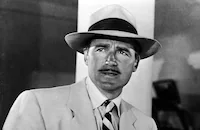Although William Holden started out playing variations on the all-American boy-next-door, it was his impressive array of world-weary cynics (Stalag 17, Sunset Boulevard) and skeptics (Executive Suite, 1954) that won him critical acclaim and Oscar nominations. Unfortunately, toward the end of his career, his reputation began to suffer due to his heavy drinking and unpredictable behavior. The Devil's Brigade was made at a point in the actor's career when he was starting to lose control. In the biography,
"Holden and the other actors were required to wade through the fast-flowing frigid water holding their weapons above their heads. A line of curious townspeople peered down at the movie company from a bridge. Suddenly Holden looked up at them and shouted, "What the f#ck are you staring at?" He opened fire with his machine gun. The Italians screamed and ran for cover. The sound of the blank shots echoed through the granite ravine, electrifying the other actors and the film crew. All stared in astonishment at Holden, whose rage was now directed at himself. Bill's embarrassment was devastating. He began downing a bottle of vodka before reporting to location in the morning. David Wolper arrived on the set one day to find Holden missing. "I'll go back to the hotel and find him," said the producer. As he was driving back to the hotel, he noticed Holden's Bentley parked outside a bar. Wolper found his star totally drunk.
"Wolper telephoned a United Artists executive in Paris. "What can I do?" Wolper asked desperately. "I've got a week and a half to shoot, and Holden is too drunk to work." "Don't worry. I've dealt with this before," the executive assured. He dispatched a Paris doctor to administer injections and arranged for a warm and sympathetic Italian beauty to come to the location from Rome to assist in the recovery. The prescription worked, and Bill was able to finish the Italian location and go on to London for the completion of The Devil's Brigade."
Although Holden continued to struggle with alcoholism right up to his accidental death in 1981 (He fell in his apartment and struck his head on a sharp table edge, bleeding to death), he will always be remembered for a great body of work which includes a Best Actor Oscar for his performance in Stalag 17, Academy Award nominations for his work in Sunset Boulevard and Network (1976), and landmark films like Golden Boy (1939), Born Yesterday (1950), Picnic (1955), The Bridge on the River Kwai (1957), and The Wild Bunch (1969).
In addition to Holden, The Devil's Brigade also features strong supporting performances by Cliff Robertson, Richard Jaeckel and Carroll O'Connor and the impressive stunts were coordinated by Hal Needham, a former US Army paratrooper during the Korean War who worked as a stunt man and bit actor before graduating to second-unit action director in the sixties. He made his directorial debut in 1977 with Smokey and the Bandit (1977).
Producer: David L. Wolper
Director: Andrew V. McLaglen
Screenplay: William Roberts, George Walton, based on the novel by Robert H. Adleman
Art Direction: Alfred Sweeney
Cinematography: William H. Clothier
Editing: William T. Cartwright
Music: Alex North
Stunts: Hal Needham
Cast: William Holden (Lt. Col. Robert T. Frederick), Cliff Robertson (Major Alan Crown), Vince Edwards (Major Cliff Bricker), Andrew Prine (Private Theodore Ransom), Jeremy Slate (Sgt. Major Patrick O'Neill), Claude Akins (Pvt. Rockwell Rockman), Richard Jaeckel (Private Omar Greco), Michael Rennie (Lt. Gen. Mark Clark), Carroll O'Connor (Major General Hunter), Dana Andrews (General Walter Naylor), Patric Knowles (Lord Louis Mountbatten), Richard Dawson (Private Hugh McDonald), Luke Askew (Pvt. Hubert Hixon).
C-132m. Letterboxed. Closed captioning.
by Jeff Stafford






























